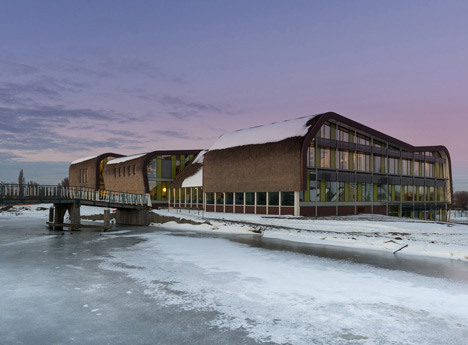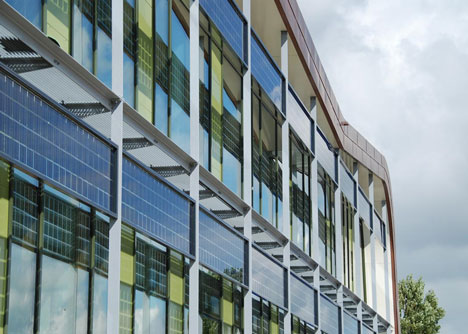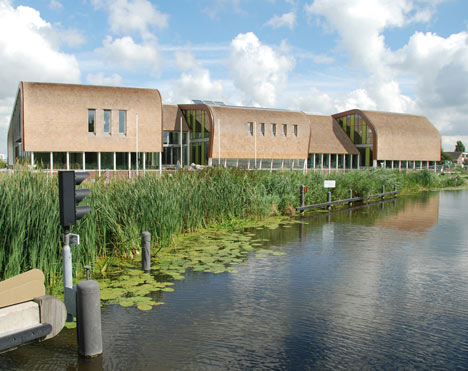 When I opened up the post on Dezeen, saw this thatched Town Hall in Midden-Delfland by Dutch architects Inbo, and read the post description, I was prepared to get my unreconstructed modernist knickers in a knot. For those of you unfamiliar with Australian slang, that means I was about to get indignantly upset, because the idea of putting thatch on these large sheds offended my mid-20th Century principles of 'honesty' of structure, and 'authenticity' of forms and materials.
When I opened up the post on Dezeen, saw this thatched Town Hall in Midden-Delfland by Dutch architects Inbo, and read the post description, I was prepared to get my unreconstructed modernist knickers in a knot. For those of you unfamiliar with Australian slang, that means I was about to get indignantly upset, because the idea of putting thatch on these large sheds offended my mid-20th Century principles of 'honesty' of structure, and 'authenticity' of forms and materials.
Then I stopped, looked a bit more carefully, thought a bit harder, and realised that while I may not fall in love, I may have come across a building I could definitely respect. First, a description edited from the Dezeen post:
The town hall comprises a row of five alternating volumes designed to match the forms of the surrounding hills. Inspired by the farmhouses typical in the region, the building has a thatched roof folding over all five of its huge curved profiles. But unlike a traditional thatched roof, which could pose a significant fire hazard, metre-long strands of reed are wrapped tightly around a system of prefabricated panels. "It looks like the reed is all over the building from beginning to end, but that's not actually the case," explained architect Arnold Homan.
You can see that at this point, I would have been getting a bit skeptical. Let's face it, the large, relatively flat roof form with the box gutter, contrasting with the idea of thatch as I understood it, was what first offended me. But the next bit of information is what grabbed my attention:
"The thatching clads all surfaces of the roof that are visible at ground level, while the uppermost sections are covered with a mixture of sedum and photovoltaic solar panels."
AHA! A vegetated roof for stormwater management, improved insulation values, summer microclimate with plants doing the shading and cooling by transpiration, vast area for unobstructed photovoltaics? OK, what else?
"Windows line the north and south facades of each block to bring natural light through every room in the building. More solar panels are mounted around the glazing and double-up as solar shades.
Honestly, they aren't doing badly, but they could do so much better. It's the way the architects have broken up the big shed - so good for adjusting the perceived scale - that also creates the vertical glazing at each break, which brings the daylight deep into the space.
Now that I was looking, of course I was seeing the payoff for the simple design strategy of taking a big shed, and incrementally tweaking it to produce a building which effortlessly accommodates a number of sustainable strategies. For instance the nested 'capsules' for conference areas and other office functions, reducing and segregating the volumes of conditioned space. The additive elements of airlocks effortlessly inserted into glazing lines. Other sustainability measures are less obvious, even hidden. Natural underground wells are utilised for heat and cold storage, contributing to a high energy efficiency score. Paving slabs for the floor of the major hall, wooden fittings and furnishings built from locally sourced timber.
I gave up being wedded to structural determinism of form twenty years ago, when an engineer colleague pointed out to me that the role of structure was to hold up whatever shape space you need, and who cares whether the structure is 'expressed' or hidden? It's sobering to think that even after that post-structuralist (pun intended) catharsis, I still retained a loyalty to a much more tenuous concept of formal 'honesty'. This building reminds me that there are other ways of producing good buildings. Probably better buildings.
Read the Dezeen article here.


4 comments:
You had me there for a moment, Steve! ;)
Likewise, I am a sucker for structural expression. While I understand that there will always be some inevitable compromises whether in a student or real-life project, expressing structure and material in their honesty can really turn a space and form into something delightful and poetically magical. And I tried to push that as much as I could during my student career.
So my question is, why is it that this end doesn't often happen in real life practice? Cost issues, client pressures, speed of design delivery, and/or us architects who are lazy? (e.g. "oh, just clad it up!")
The little practice I worked at briefly before I went to Hidden Valley was just like that.
Even a modest house up in Wentworth Falls I am now helping a good friend of mine to look at and remodel - have the same issue that afflicts most Australian houses - cheap roof trusses to span and create the classic pitched roof form, and then concealed above a false ceiling. When that house could have had a very magical interior should the original architect have chosen to express the roof space and structure into the interior space!
Ren Jie,
Cost. COST and speed. The vernacular of single dwellings at any moment in time is likely to be the most cost effective way of getting a certain amount of accommodation built.
You CAN compete with it, but only by considerable effort and ingenuity. If you are trying to do it as an architect, it becomes a trap, because the 'good thing' clients repeat about you is that you matched or bettered the project home prices. You end up with an entire clientele more interested in that, than what else you could do for them. Been there, and it was exhausting and frustrating, once the initial sense of achievement wore off.
But with the big shed, I wasn't kidding.I like it for the clever strategy. Once you throw up the big space, you can do just the right thing with all the little functional bits, without trying to torture a per-conceived complex form. Some Japanese architects are really adept at doing the same at a tiny scale, putting up a shell at the limits of the site, and carefully inscribing into it the finely wrought spatial experience, of ten using extremely simple structure and materials.
That's what I've begun to realise too! Re Japanese architects and their space-crafting under the shed, I have been thinking why aren't more architects doing the same here in Oz.
Many of the new constructions I see around in the Blue Mtns still conform to the same cottage-type or MacMansion aspirations, with a clumsy roof form trying to keep up with a clumsy floor plans, when they could have unified the floor plan very cleanly under a big roof or two.
‘Is true to structure important?’ has been an important aspect being always emphasized since modernism comes along. However, I have been curious about how to define the ‘truth’. Originally I would say it is about any structure element exposed should be the structure it actually is, without ornament to fake it into other kind.
As the time comes along, understanding of architecture has begun to allow different thinking in my mind. As Donald Davidson stated in ‘The Structure and Content of Truth’, the idea of truth is what it works, leading us to what it purports (P279-283). In my understanding, it would be reasonable to have true exposed structure being transferred into something what human believe and desire. For example, thin steel column wrapped with concrete in order to achieve appropriate thickness of structure component for providing sense of security to occupants. Therefore, as an ‘authentic form’ presented in typical farmhouse region with green recreational feature in Netherland, it would be safe to say that choice of thatching the viewed roof wouldn’t be the worst thing. Additionally in this case, what I found interesting is, the thatch roof comes with sedum and photovoltaic solar panels on uppermost section to maintain its sustainable feature. Secondly, those tight metre-long reeds are sitting on top of big prefabricated panels to minimise the possibility of fire quickly growing caused by air feeding from below. It again emphasizes that evil is in detail, no matter what kinds of exposed structure you are considering about.
Therefore, since human are the one most strongly associated factor with architecture and the space it creates, exposed structure wrapped by other material or intentionally showing a non-existing structure component which would related to human interests and beliefs can be considered as viewed truth, and taken into account of ‘truth’.
http://www.dezeen.com/2013/04/17/town-hall-midden-delfland-by-inbo/
http://www.jstor.org.wwwproxy0.library.unsw.edu.au/stable/2026863?seq=5
Post a Comment